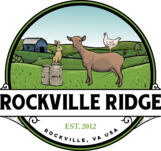Resources
There is already a wealth of information available online about goats and their care. I have created this page to simply share some of our experiences and recommendations. I have included many links to other content providers rather than re-creating content that has already been well put together. There is often not a single right answer to caring for your animals – just like parenting. Of course, you are solely responsible for the welfare of your animals and the information provided here is not meant to take the place of veterinary care. However, I hope this page is helpful for those of us still learning – constant learning is one of my favorite parts of homesteading! There is NEVER a lack of things to learn or add to the To-Do list!
Table of Contents
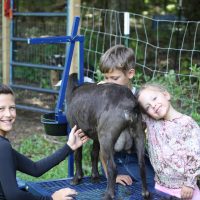
Basic Goat Care 101
Goats are generally hardy and adaptable animals and not especially difficult to care for, but there are a few things they really need to thrive.
Companionship – Goats are herd animals and definitely need other goats as companions. Other livestock or pets really don’t count as goat companions. So, you really need at least 2 goats. A “Wether” (castrated / neutered male goat) can be a wonderful companion to female or male goats and are generally not expensive as they cannot breed and don’t produce milk. So, if you only want one female goat, a wether as a companion works well so she is not lonely. Wethers can also be companions to intact male bucks. However, an intact male buck should not be kept with females – more detail on that in the “breeding” section. If you decide to keep a male goat for breeding, he will also need a companion. Intact males and your females should be housed and fenced separately if you decide to keep both.
Housing – Goats need a shelter to protect them from the weather. Goats especially hate being wet and will almost always stay in the shelter during rain.
- The shelter needs to keep them dry and draft free when it is cold.
- Ideally, shelters can be closed to protect your goats from predators, which is especially true for young goats.
- I like having a shelter that allows for feeding hay and water inside so the hay also stays dry and is available during bad weather. A “Lean-to” on the side of an existing outbuilding works really well. If you can’t feed inside the shelter, do ensure that the hay will be fed under cover to keep it dry as mold + goats is a recipe for disaster. You need to keep hay and minerals dry.
- I also prefer a dirt floor with bedding on top – deep litter method. If the floor absorbs / drains, the pee doesn’t sit on top and bedding stays fresher longer. If you have concrete or stall mats, you will need to change bedding OFTEN! With an earth floor, you may only need to empty the bedding a couple times a year. This excess bedding also helps keep animals warm in the winter.
- Goats do NOT need heat lamps if they have adequate shelter. They develop a nice layer of cashmere under their coats for winter and they shed this undercoat in the spring. Putting coats on goats when weather starts to get cold will inhibit the development of their cashmere undercoat and actually make them colder. Don’t do coats and heat lamps in general.
Fencing – Goats need a fenced area to both keep them where they belong, and to keep them safe from predators. Goats are prey animals and are not generally good at protecting themselves, especially if they don’t have horns. Their instinct is to run. Both wild and stray domesticated dogs are the top killer of goats and your fencing is to keep these predators out just as much as it is to keep your goats contained. There is a separate section on fencing on this page. The general recommendation is to provide at least 1500 square feet per animal of fenced space. This can be slightly smaller for miniature breeds.
Food – Goats are ruminants and need hay or quality pasture to eat. Hay needs to be fed in a dry location, up, off the ground. Goats are surprisingly picky and will often reject any hay that falls to the ground. They are also notorious hay wasters. There are a lot of hay feeder designs for reducing waste. I recommend staying away from “keyhole” style feeders which can cause injury if the goat has its head in the keyhole and is rammed by another goat. These keyhole designs don’t allow the goat to see beside / behind while eating. It is helpful generally to have a feeder that requires the goat to put its head into the feeder and “commit” to eating, rather than a feeder that allows the goat to pull hay out to eat. For example, net and wall-hung feeders generally are stuffed with hay and the goats go and “pull” hay out of the feeder – then, they drop half and pull more out. If the feeder requires the goat to put its head into a trough, they may still drop half, but it stays in the feeder.
Hay and forage (browse) is the most important food. Get as good quality hay as you can find / afford. Be wary of sellers offering you “goat quality hay”. This hay is often bottom bales that are dusty or moldy, or older hay with less nutrition left. I always ask for “horse quality hay”. If you have does in milk, alfalfa hay helps support lactation and fetal development in late gestation due to its higher calcium content.
Goats do not really need “goat feed”, especially males. However, a good feed or goat specific grain mix is usually fed on the stand during milking to keep them busy and to provide calories to support good body condition during milk production – General rule for grain amounts is 1# of grain per 1-3# of milk produced. So, for twice a day milking, that would be appox. 1 – 1.5 cups in the morning and again at the evening milking for Nigerians.
Water – Goats need fresh water every day – ideally twice a day! For all the “Goats will eat anything” rumors, they are actually quite picky. Goats prefer to not drink water that is not fresh (I wouldn’t either!). For us, if I wouldn’t drink it, we change it – which ends up being at least once a day. It is especially important that females (does) in milk are drinking plenty of water to support milk production. It is worth your time to keep the water fresh and clean. We personally like the rubber water bowls from the feed store because it is easy to clear frozen water from them in the winter because of the rubber’s flexibility.
Minerals – Goats have different mineral needs than cows or sheep – especially for copper. They need loose minerals available “free choice”. Free choice means it is always out and available for them. Mineral blocks are not a good choice for goats as they can be rough on their sensitive tongues. Loose minerals are a better choice. Minerals need to be kept dry, so a location inside the shelter, and easily accessible, is the best location. Loose minerals can be bought at your local feed store. I believe the best minerals are Sweetlix Meat Maker and Purina Goat mineral – both have sufficient copper and aren’t mostly salt. At Rockville Ridge, we use Sweetlix, which is available through Rockingham Co-op in Western & Central VA. Purina Goat Mineral is generally available at most farm stores. An excellent article about goat minerals can be found at the Thrifty Homesteader here: https://thriftyhomesteader.com/goat-minerals/
Hoof Care – Goats need their hooves trimmed periodically. How often will depend on the breed and age of the goat as well as your terrain. Just like us, some goats also grow nails faster than others. We end up trimming about every 6-8 weeks. If they are wearing down their hooves naturally due to your terrain (i.e. rocks), you will not need to trim as often. There is an excellent facebook group just about goat hoof trimming called “Goat Hoof Maintenance 101”. This group is full of professional hoof trimmers and beginner questions. I personally enjoy trimming hooves – if you purchase goats from me, I will be happy to help you learn how to maintain your goat’s hooves if you need help. General supplies required are a simple hoof brush/hoof pick and hoof trimming shears. My favorite shears are the ARS 140 DXR Trimmers. I like the serrated ones (it’s a micro-serration). These trimmers are about $45, but they stay sharp for years vs. the $25 pair I started with. Either will work though – it’s more important to keep them trimmed well than worrying about getting the right trimmers. Allowing hooves to over-grow can cause hoof-rot and ultimately lead to lameness.
Parasite Management – Goats are susceptible to a number of internal and external parasites. Learning to check a goat’s eyelids for signs of anemia, paying attention to their coat, and having a relationship with a large animal veterinarian can be a huge help in identifying which parasites you might be dealing with – if any. Ask your breeder about their approach. At Rockville Ridge, we do not deworm on a schedule. I disagree with “preventative worming”. Overuse of wormers and antibiotics leads to drug resistance. We only deworm or treat for coccidia if there is a fecal done to confirm what parasites we are dealing with, and confirming the amount of parasites mixed with clinical symptoms requires treatment. All goats will have some parasites, the goal shouldn’t be to have zero parasites, but instead to have goats who are able to avoid clinical illness and who are resistant to parasites. Management of grazing can also help avoid parasite issues. This is a much larger conversation, but goat owners do need to consider how they will manage parasites in their herd. There is a bit more on parasites under “Health Issues” on this page.
Don’t let this list overwhelm you. It might look like a lot, but it boils down to Shelter, Water, Hay, Minerals and hoof trimming. Buying from an experienced breeder can make things easier as those of us breeding goats are generally doing so for the love of the breed and are happy to answer questions. It is wise to ask your breeder about their philosophy and how they feed their animals anyway, as trying to maintain a similar diet for the goat upon moving to a new home can ease some of the stress of moving. Avoid any sudden changes to their diet if at all possible.
If you follow these basics, and buy healthy animals to start, you should have an easy start to your goat keeping journey!
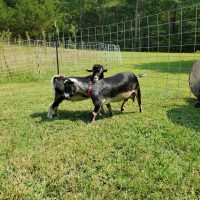
Breeding
Breeding season is an exciting time. Some Nigerians cycle all year, but ours seem to start cycling in early August. Does come into heat about every 21 days during the season. Standing heat only lasts 6-36 hours, making it easy to miss if you aren't prepared. We do not recommend running bucks with does for many reasons. Keeping bucks does mean that you need to care for, and house, those bucks even when they are only needed for a short part of the year; however, owning your own bucks is the easiest way to manage timing of breedings and to avoid biosecurity risks. I recommend keeping your own bucks if possible - and would be happy to help you find a buck from one of our breedings that would help you meet your herd goals. There are other options for breeding if you do not have a buck - some include renting a buck, coordinating a "driveway date" with a buck on another farm, and Artificial Insemination (AI). Keep in mind that anytime you introduce animals from another farm to your animals or property, you do expose yourself to biosecurity risk. For this reason, we maintain a closed herd and do not rent our bucks or breed with other herds. However, it is an option that works for many. If you are interested in learning more about AI, I have included additional resources below. Our Approach -- Once one of our does is in standing heat, assuming it's a month that we would like her bred, she is only then put in a temporary pen with a buck for a "date" that generally lasts about 30 minutes. If the doe appears to still be in heat the following day, we will put them together one more time if she is receptive. This approach "pen breeding" or "hand breeding" ensures we don't have accidental breedings and that we know the exact due date. If you leave bucks with your does, you will have no control over breeding and will not know when to expect kids. Without a known due date, it will be very difficult to give the doe proper prenatal care (proper dry date, late gestation diet, etc) and may risk her health or that of her kids. In 2021, I had a doe struggle with both Ketosis and Hypocalcemia because of improper feeding late gestation. What really happened was that she came down with Listeriosis just 3 weeks before she was due. This illness threw her off feed and set her into a cascade of metabolic issues during those 3 weeks prior to kidding. By God's grace, she pulled through AND had a successful kidding of triplets! I learned a lot about the importance of nutrition in pregnancy - especially for goats carrying multiples. The For the Love of Goats podcast has 2 excellent episodes on preventing & reversing Ketosis and Hypocalcemia (aka Milk Fever). Some additional resources: Gestation - 145 days for miniature breeds & 155 days for standard breeds "Breeding Season" For the Love of Goats podcast: https://www.stitcher.com/show/for-the-love-of-goats/episode/breeding-season-78203350 "Breeding Season" video by Twin Pear Farm on YouTube: https://youtu.be/_xwcsI3nU4I "Artificial Insemination in Goats" For the Love of Goats podcast: https://thriftyhomesteader.com/artificial-insemination-in-goats/ "Pregnancy Toxemia in Goats" For the Love of Goats podcast: https://thriftyhomesteader.com/pregnancy-toxemia-in-goats/ "Hypocalcemia in Goats" For the Love of Goats podcast: https://thriftyhomesteader.com/hypocalcemia-in-goats/
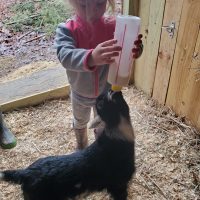
Dealing with Goat Health Issues
Are goats difficult to take care of? They are definitely harder than chickens and house pets - especially when you are a new owner! It can be difficult to know what is normal, what issues you can take a "wait & see" approach vs. what should "never be ignored". It certainly helps if you understand how a healthy goat looks & behaves! Goats are generally alert and curious. Each goat has their own personality for sure, and spending time with them will help you recognize if they are "off". There is often one goat that is quieter than the others, more bossy, most likely to get into trouble, etc . When you learn these personality differences, you will more easily recognize that your usually quiet doe is calling out today, which is not normal for her. Paying attention to their general countenance and keeping an eye on the poops will get you a long way in keeping them healthy. Some general information to help recognize illness... Activity - a goat should spend about 30% of the day eating, 30% chewing the cud, and 30% sleeping. If your goat always gets up to greet you every time you enter their area and today doesn't get up to greet you - keep an eye on them and watch for other changes. Are they less aggressive at the feeder, lethargic, dull in the eyes, etc. These minor changes to their countenance can be an early sign of something brewing. These behavior changes would lead me to do a more thorough assessment as I outline below. As a livestock owner, having a relationship with a large animal veterinarian is super important. There are a couple of great vets in the central VA area that are experienced with goats. There are also some helpful goat groups on Facebook. I am a member of many of these groups and my favorite “goat health” related group is called “Goat Emergency Team”. This group has 50k members and 20+ volunteer moderators that are all experienced goat farmers. The group shouldn’t be used in lieu of a relationship with a veterinarian, but I do recommend joining the group and looking through the files they have for various health concerns. This group maintains protocol files for treating everything from animal attacks, bloat, listeriosis, pneumonia, proper medication dosages for goats, etc. However, I would NOT recommend "scrolling" on this group page. It can look like it's impossible to keep goats alive. Consider the protocols under the "albums" section of the page, but avoid scrolling the page.
Before calling a veterinarian or asking for help online, do a basic assessment so you can properly explain what you are observing in your herd. Basic Goat Assessment Temperature - Normal range 101.5 - 103.5 degrees F - owning a thermometer (or 2!) is a must. Insert 1.5" into rectum for a good temperature. Rumen (stomach) movements - Ensure rumen is active by listening with the ear against the goat's left side - you should hear 1 - 1.5 "swishes" per minute. Stools - poop should be individual pellets without much smell. What do you see? Is it like dog poop? Like grenades? Watery? Mucousy? Bloody? Physical Symptoms - Is your goat lethargic? Laying down? Unable to stand? Eating & Drinking normally? Any head pressing or teeth grinding? Foaming? Neurological symptoms like eye twitching, circling, neck pulled to one side? Respiratory symptoms like wheezing, coughing, runny nose? Skin issues - bugs, eggs, nits, or scaly patches, bald patches? FAMACHA score - It can be helpful to know an animal’s FAMACHA score. FAMACHA is a tool used to try to assess the level of parasites in the animal by looking at the color of the inner mucous membrane of the eye. I have included 2 videos about FAMACHA scoring below - a very 1 min example and a longer explanation. A fecal egg count is the best in terms of quantifying true parasite levels, but a poor FAMACHA score indicates anemia, which would need to be addressed. Parasite management is a whole topic on its own. Quick 1 minute FAMACHA example (Univ of RI): https://youtu.be/tmeZkqGQnMg 30 min FAMACHA “Why & How” (Univ of RI): https://youtu.be/I5rcuvVG56Q I personally treat all abnormal poops (grenades & dog poop look) with ProBios probiotics as a starting point. Never ignore diarrhea (aka "Scours"). Diarrhea is a SYMPTOM of an illness, not an illness in itself. Bacteria, viruses, parasites and management practices (overcrowding, poor sanitation or nutritional problems (like over feeding, poor quality milk replacers, sudden changes in feeding schedules, ingestion of lush, wet grasses, etc.) are all causes of diarrhea. It’s always best to take a fecal to determine the cause, but all cases will carry a risk of dehydration. For goats over 12 weeks with diarrhea, pull all grain and feed only hay and alfalfa along with fresh browse. Offering some electrolytes in one bucket along with their regular water will keep them from becoming dehydrated. I would still do probiotics and also always recommend having a fecal run by the vet when dealing with diarrhea or persistent abnormal poop - especially if combined with a worsening FAMACHA score. The fecal will help determine what you are dealing with so you can identify an effective treatment. We do not offer free choice baking soda at Rockville Ridge, but we do put it out when anyone is having abnormal poops or when grass is first coming back in the spring if someone looks a little overfull. We do always have mineral available free choice and we like Sweetlix Meat Maker Mineral.
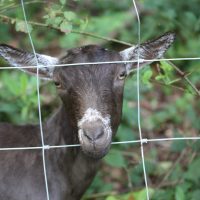
Fencing
Fencing is a very important part of keeping goats - although, it's not been our experience that "any fence that won't hold water won't hold goats". We've found that Premier1 electric fencing works very well for us and that as long as the goats have food, they aren't difficult to keep fenced. I love that I can change my fence lines easily with the electric netting. I also found that using electric netting allowed me to move my fencing many times as I got started and wasn't certain how I wanted to layout my pens. It also allowed flexibility as I added goats. We do still use some wire fencing around the barn and the perimeter of our property, but the electric has been great. The only issue we have struggled with is keeping the fence well energized since we use our woods as our majority space for the goats and our energizers are solar-powered. Goats are SMART! They will figure it out if your fence isn't energized and that can cause a dangerous tangling hazard at worst and lead to accidental breedings as well. So, if you go with electric, be sure you have a good energizer with plenty of sun - or a plug-in unit. You must also train your goats to the fence. If you do not use an electric fence, beware that goats WILL climb on, and rub on, a non-electric fence and tend to push it over if not well constructed. Cattle panels for fencing can work quite well on level ground, but their price has doubled here in the past two years. We do use cattle panels for a temporary breeding pen each year and as permanent fencing in areas where there is a short run that needs to be made to connect two separate electric netting zones. Nigerian Dwarf kids can get through regular cattle panels for quite a long time so we are careful about using them in areas where kids will frequent. Fences also need gates. I love the auto-locking fence gate latches and use them on all our gates. These gates allow you to use them one handed, which is so handy when you have milking supplies in hand, and you can open the gate either direction and it will lock automatically when closed. A link to these latches is below. Whether you use electric or wire fencing, you must make sure it is secure - holes must be small enough to keep kids from slipping through and it must be secure enough to keep predators out. Some additional resources: Speeco Two-Way Locking Gate Latch: https://www.tractorsupply.com/tsc/product/speeco-two-way-lockable-gate-latch Premier1 Supplies Electric Netting: https://www.premier1supplies.com/c/fencing/

Why Registered Goats?
(Coming Soon)
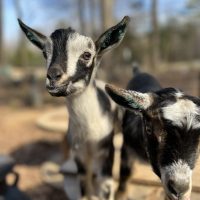
Some of My Favorite Resources
(Coming Soon)
